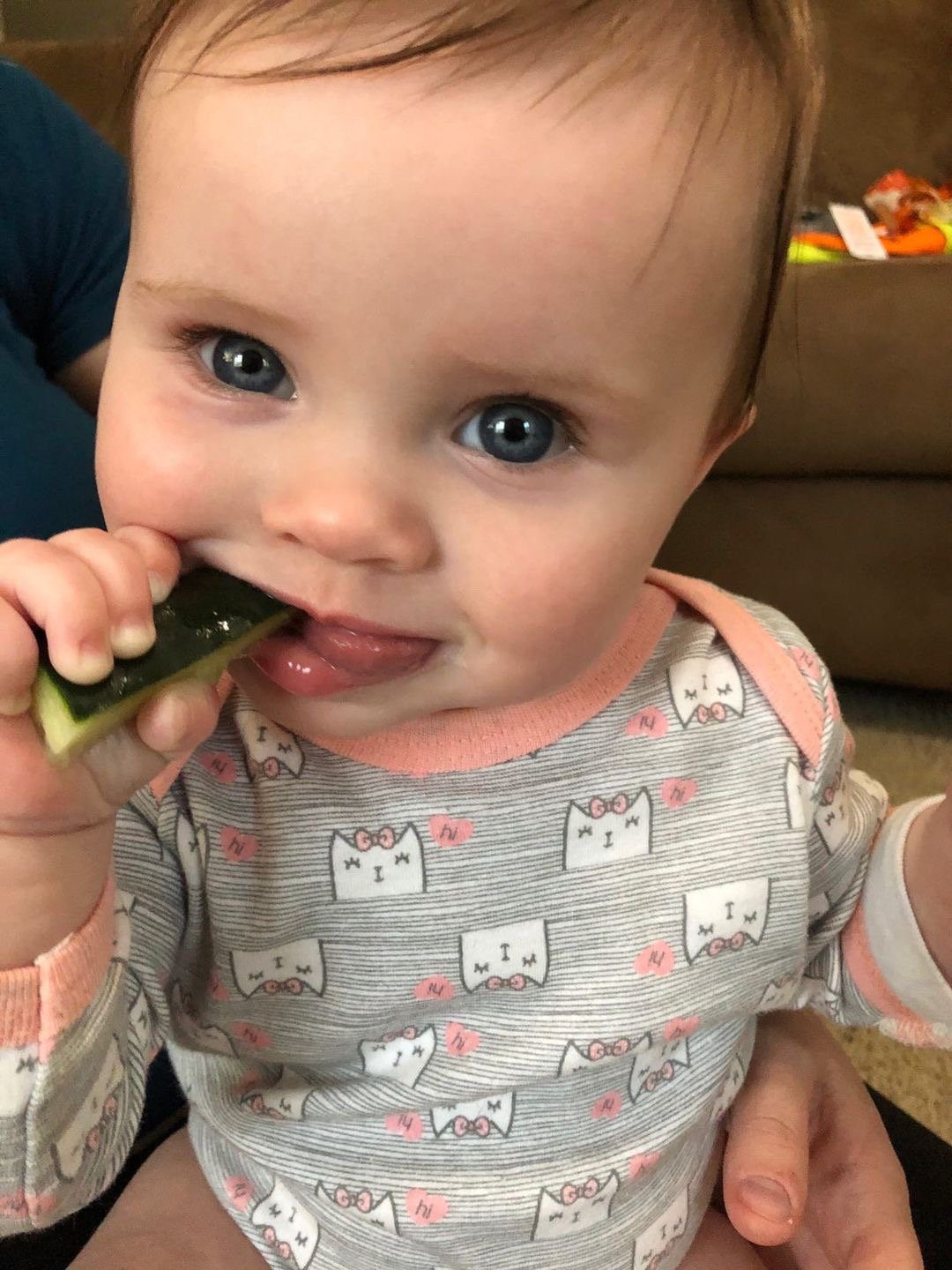How to Cut Cucumber for Baby: Expert Tips
To cut cucumber for a baby, start by removing the tough outer skin and any large or firm seeds. Cut the cucumber lengthwise into spears and offer them to your baby to suck and chew.
Once your baby develops a pincer grasp, you can leave the skin on and cut the cucumber lengthwise into thin wide slices.
1. Introduction To Cutting Cucumber For Babies
To cut cucumber for babies, start by removing the tough outer skin and the seeds, as they can be a choking hazard. Offer the cucumber in thin wide slices for younger babies to suck and chew, and in spears for older babies with a pincer grasp.
Introducing solid foods to your baby’s diet is an exciting milestone, and one food that you may consider adding is cucumber. Cucumbers are not only refreshing and hydrating, but they also provide a range of health benefits for your little one. However, it’s important to know how to cut and prepare cucumber for babies to ensure it is safe and easily digestible. In this article, we will explore the importance of introducing cucumber to your baby’s diet, the health benefits it offers, and provide safety guidelines for feeding cucumber to babies.
Importance Of Introducing Cucumber To Baby’s Diet
When it comes to introducing solid foods, variety is key. Adding different fruits and vegetables to your baby’s diet helps expose them to a wide range of nutrients and flavors. Cucumber is a great choice for the introduction of new textures and tastes. Its mild flavor and crisp texture make it an ideal food for babies who are just starting to explore solid foods.
Health Benefits Of Cucumber For Babies
Cucumbers may be filled with water, but they also come packed with essential vitamins and minerals that are beneficial for your baby’s health. Here are some of the key health benefits of including cucumber in your baby’s diet:
- Nutrient-rich: Cucumbers are a good source of vitamins A, C, and K, as well as potassium and fiber.
- Hydrating: With their high water content, cucumbers help keep your baby hydrated, especially during hot weather.
- Easy to digest: The soft and easily chewable nature of cucumber makes it gentle on your baby’s developing digestive system.
- Anti-inflammatory properties: Cucumbers contain antioxidants that help reduce inflammation and support overall health.
- Supports healthy digestion: The fiber content in cucumbers aids in regular bowel movements and promotes a healthy digestive system.
Safety Guidelines For Feeding Cucumber To Babies
While cucumbers offer numerous health benefits, it’s crucial to follow safety guidelines when incorporating them into your baby’s diet. Here are some important safety tips to keep in mind:
- Remove the skin and seeds: Before offering cucumber to your baby, peel off the tough outer skin and remove any large or firm seeds. This minimizes the risk of choking and ensures easier digestion.
- Choose organic cucumbers: Opt for organic cucumbers to avoid exposing your baby to pesticides and ensure a cleaner option.
- Introduce one new food at a time: When introducing cucumber to your baby, offer it separately from other new foods. This allows you to monitor any potential allergic reactions or digestive issues.
- Supervise your baby: Always closely supervise your baby while they are eating to prevent choking hazards. Cut cucumbers into age-appropriate shapes, such as sticks or thin slices, to make it easier for your baby to handle.
- Start with small portions: Begin by offering your baby a small portion of cucumber and observe how they react to it. If they enjoy it and tolerate it well, you can gradually increase the amount.
By following these safety guidelines, you can ensure a pleasant and safe cucumber-eating experience for your little one. Remember, each baby is unique, so pay attention to their cues and consult with your pediatrician if you have any concerns or questions.
2. Preparing Cucumber For Baby-led Weaning
When it comes to introducing solid foods to your baby, cucumber can be a refreshing and healthy option. However, it is important to prepare the cucumber in a way that is safe and appropriate for your little one’s age. In this section, we will cover the steps to follow when preparing cucumber for baby-led weaning.
Removing The Tough Outer Skin And Seeds
When you first introduce cucumber to your baby, it is crucial to remove the tough outer skin and seeds. Not only does the skin pose a choking hazard, but it also leaves you susceptible to ingesting pesticides without proper cleaning. As cucumbers age, the seeds become bitter, so it is best to remove them before eating.
Washing Cucumber Thoroughly To Remove Pesticides
Prior to preparing the cucumber, it is important to wash it thoroughly to remove any pesticides or dirt. Start by rinsing the cucumber under cold water and use a vegetable brush to scrub the skin gently. This will help remove any contaminants that might be present on the surface. After a thorough rinse, pat dry the cucumber with a clean kitchen towel or paper towel before proceeding with the next step.
Slicing Cucumber Into Appropriate Sizes For Baby’s Age
Now that the cucumber is clean and the tough outer skin and seeds are removed, it’s time to slice it into appropriate sizes for your baby’s age. For younger babies, around six to eight months old, slices are generally the best option. Aim for thin slices that are easy for your little one to hold and manipulate in their hands.
As your baby grows older and develops better chewing and swallowing skills, you can gradually increase the size of the cucumber slices or try cutting them into stick-shaped pieces. Just make sure the pieces are soft enough for your baby to chew and swallow safely.
Remember, it’s always important to closely monitor your baby while they are eating cucumber or any other finger foods to ensure they are chewing and swallowing properly.
3. Serving Cucumber To Babies
To cut cucumber for your baby, start by removing the tough outer skin and seeds to avoid choking hazards and pesticide ingestion. As your baby grows, you can leave the skin on for added nutrition and cut the cucumber into spears or thin wide slices for them to suck and chew.
Steamed Cucumber Sticks For Younger Babies
For younger babies who are just starting their solid food journey, steamed cucumber sticks are a great option. Steaming cucumbers not only makes them soft and easy for babies to chew, but it also helps preserve their nutritional content. Here’s how you can prepare steamed cucumber sticks for your little one:- Start by washing the cucumber thoroughly to remove any dirt or pesticides. Peel the tough outer skin using a vegetable peeler, as it can pose a choking hazard for babies.
- Cut the cucumber in half lengthwise and remove any large or firm seeds. This step is important as cucumbers’ seeds can also be a choking hazard.
- Take one half of the cucumber and cut it into thick sticks, making sure they are of an appropriate size for your baby to hold comfortably.
- Place the cucumber sticks in a steamer basket and steam them for about 5-7 minutes until they become tender.
Mashed Cucumber For Older Babies
As your baby grows older and transitions to more textured foods, mashed cucumber can be a great addition to their meals. Mashing the cucumber makes it easier for babies to consume while still providing them with the refreshing taste and nutrients. Here’s how you can prepare mashed cucumber for your older baby:- Wash the cucumber thoroughly and remove the tough outer skin.
- Cut the cucumber in half lengthwise and scoop out any large or firm seeds.
- Using a fork or a potato masher, gently mash the cucumber until it reaches a smooth consistency.
- You can serve the mashed cucumber as a standalone puree or mix it with other fruits or vegetables for added flavor and nutrition.
Incorporating Cucumber In Purees And Baby-friendly Recipes
Cucumbers are not only a nutritious snack on their own but can also be incorporated into various purees and baby-friendly recipes. Here are a few ideas on how you can introduce cucumber into your baby’s meals:- Add mashed cucumber to homemade baby food purees, such as cucumber and spinach or cucumber and banana.
- Blend cucumber with Greek yogurt and a pinch of mint to create a refreshing and creamy dip for baby-friendly crackers or vegetable sticks.
- Make cucumber-infused water by adding thin cucumber slices to a pitcher of water. This can be a great way to introduce your baby to different flavors while staying hydrated.
- Include cucumber in baby-friendly salads by combining diced cucumber with other soft fruits and vegetables.

Credit: www.halfyourplate.ca
4. Safety Tips For Cutting Cucumber For Babies
When it comes to introducing solid foods to babies, it is important to prioritize their safety. Before cutting cucumber for babies, it is crucial to be aware of the safety measures that need to be taken. Here are some safety tips for cutting cucumber for babies to ensure a safe and enjoyable feeding experience.
Using Safe Cutting Techniques And Tools
When it comes to cutting cucumber for babies, using safe cutting techniques and tools is essential. Here are some important considerations:
- Choose a sharp knife: Use a sharp knife to cut the cucumber, as it ensures clean and easy cuts.
- Hold the cucumber firmly: Hold the cucumber firmly while cutting to ensure stability and prevent any accidental slips.
- Use a cutting board: Place the cucumber on a stable cutting board to provide a flat surface for cutting.
- Always cut the cucumber into age-appropriate sizes: For babies, it is recommended to cut cucumber into small, soft pieces to reduce the risk of choking.
Supervision During Feeding To Prevent Choking Hazards
Supervision is crucial during feeding time, especially when introducing new foods like cucumber to babies. Here are some tips to prevent choking hazards:
- Always watch your baby: Keep a close eye on your baby while they are eating cucumber to ensure they are chewing and swallowing safely.
- Encourage small bites: Teach your baby to take small bites of cucumber to reduce the risk of choking.
- Avoid distractions: Minimize distractions during feeding time, such as toys or electronic devices, to help your baby focus on eating.
- Do not leave your baby unattended: Never leave your baby alone while they are eating cucumber, as it increases the risk of choking.
Storing Cut Cucumbers Properly To Maintain Freshness
Proper storage of cut cucumbers is important to maintain their freshness and prevent spoilage. Here are some guidelines:
- Refrigerate cut cucumber: Place the cut cucumber in an airtight container and store it in the refrigerator to keep it fresh.
- Consume within a few days: It is best to consume the cut cucumber within a few days to ensure optimal freshness.
- Avoid exposure to air: When storing the cut cucumber, make sure to press down firmly on the airtight container to minimize air exposure.
- Discard if there are signs of spoilage: If the cut cucumber develops an unpleasant odor, sliminess, or discoloration, it is recommended to discard it.
5. Introducing Cucumber To Your Baby’s Diet
Introducing cucumber to your baby’s diet is easy when you know how to cut it properly. Remember to remove the tough outer skin and seeds, which can be a choking hazard, and slice the cucumber into small, manageable pieces for your little one to enjoy.
One of the exciting milestones in your baby’s journey of food exploration is introducing new fruits and vegetables into their diet. Cucumbers, with their mild flavor and crunchy texture, are a popular choice for many parents. However, it’s important to approach this introduction in a safe and age-appropriate manner to ensure your baby’s health and enjoyment.Age-appropriate Stages For Introducing Cucumber
When it comes to introducing cucumbers to your baby, it’s crucial to consider their age and developmental stage. As a general guideline, most babies are ready to try cucumber around 6 to 8 months of age. At this stage, they are typically able to sit up with support and have developed some basic chewing and swallowing skills. To make cucumber safe for your little one, start by peeling off the tough outer skin and removing the seeds. This not only eliminates a potential choking hazard but also ensures your baby isn’t exposed to any ingested pesticides. You can thinly slice or cut the cucumber into small, soft pieces that are easy for your baby to hold and manipulate.Gradually Increasing The Amount Of Cucumber In Baby’s Diet
Once your baby has successfully tried cucumber and shown no signs of allergies or digestive issues, you can gradually increase the amount in their diet. Begin by offering a small portion, such as a few thinly sliced pieces, and observe how your baby reacts. If they enjoy it and tolerate it well, you can gradually increase the serving size over time. Remember that each baby is unique, and their readiness for new foods varies. It’s always best to consult with your pediatrician or a registered dietitian before making any significant changes to your baby’s diet.Recognizing And Addressing Any Potential Allergies Or Digestive Issues
When introducing any new food to your baby, including cucumber, it’s important to be vigilant for any signs of allergies or digestive issues. Allergies can manifest as skin rashes, hives, swelling, or difficulty breathing. Digestive issues may include stomach discomfort, diarrhea, or constipation. If you notice any concerning symptoms, discontinue feeding cucumber to your baby and consult a healthcare professional for further guidance. They can help determine if the symptoms are related to an allergy or if further testing is needed. Remember that every baby is different, and it may take a few attempts before your little one develops a taste for cucumbers. Be patient, offer a variety of flavors and textures, and let your baby explore the world of food at their own pace. Enjoy this exciting journey of introducing new foods to your baby and watching them discover their preferences and develop a lifelong love for healthy eating.Frequently Asked Questions On How To Cut Cucumber For Baby
What Is The Safest Way To Cut Cucumber For Baby?
To safely cut cucumber for babies, remove the tough outer skin and seeds as they pose a choking hazard and may contain pesticides. Cut the cucumber into spears or thin wide slices, and offer them for your baby to suck and chew.
Leave the skin on for added nutrition once your baby develops a pincer grasp.
Should You Take Skin Off Cucumber For Baby?
When introducing cucumber to your baby, it is recommended to remove the tough outer skin and seeds. The skin can be a choking hazard and may contain pesticides. As the cucumber ages, the seeds can become bitter, so it’s best to remove them before feeding.
How Do I Cut My 9 Month Old For Food?
To cut cucumber for your 9-month-old, start by removing the tough outer skin and seeds. Cut the cucumber lengthwise into spears and offer them to your baby to suck and chew. You can leave the skin on for added nutrition once your baby develops a pincer grasp.
Remember to cut the cucumber into small, safe pieces.
What Week Is Baby A Cucumber?
Your baby is as big as a cucumber. To serve cucumbers to your baby, remove seeds and cut them into spears for them to suck and chew. Consider leaving the skin on for added nutrition once your baby can grasp with their fingers.
Conclusion
To safely cut cucumbers for your baby, it is important to remove the tough outer skin and seeds, as they can pose a choking hazard. Additionally, removing the seeds helps to eliminate any bitterness. As your baby develops a pincer grasp, you can consider leaving the skin on for added nutrition.
Offering the cucumbers in spears or thin slices allows your baby to explore different textures while enjoying this nutritious food. Remember to always supervise your baby during mealtime to ensure their safety.








